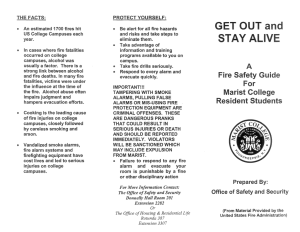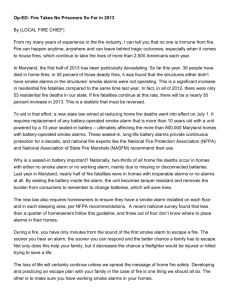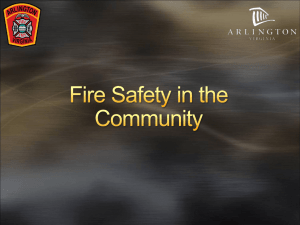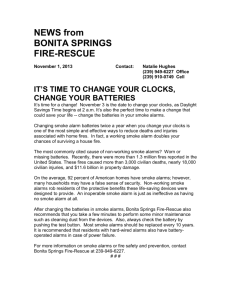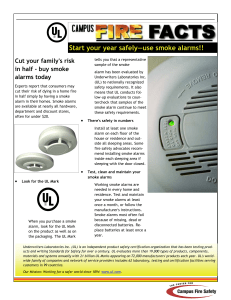S Smoke Alarms: The Science Behind Detection
advertisement
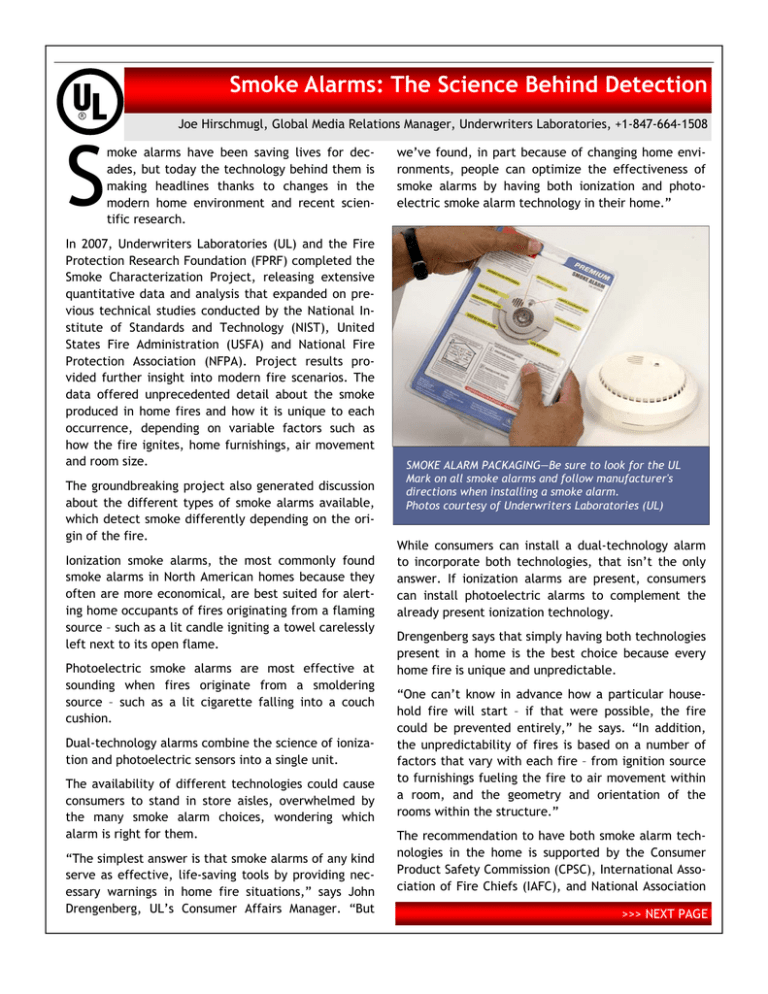
Smoke Alarms: The Science Behind Detection S Joe Hirschmugl, Global Media Relations Manager, Underwriters Laboratories, +1-847-664-1508 moke alarms have been saving lives for decades, but today the technology behind them is making headlines thanks to changes in the modern home environment and recent scientific research. In 2007, Underwriters Laboratories (UL) and the Fire Protection Research Foundation (FPRF) completed the Smoke Characterization Project, releasing extensive quantitative data and analysis that expanded on previous technical studies conducted by the National Institute of Standards and Technology (NIST), United States Fire Administration (USFA) and National Fire Protection Association (NFPA). Project results provided further insight into modern fire scenarios. The data offered unprecedented detail about the smoke produced in home fires and how it is unique to each occurrence, depending on variable factors such as how the fire ignites, home furnishings, air movement and room size. The groundbreaking project also generated discussion about the different types of smoke alarms available, which detect smoke differently depending on the origin of the fire. Ionization smoke alarms, the most commonly found smoke alarms in North American homes because they often are more economical, are best suited for alerting home occupants of fires originating from a flaming source – such as a lit candle igniting a towel carelessly left next to its open flame. Photoelectric smoke alarms are most effective at sounding when fires originate from a smoldering source – such as a lit cigarette falling into a couch cushion. Dual-technology alarms combine the science of ionization and photoelectric sensors into a single unit. The availability of different technologies could cause consumers to stand in store aisles, overwhelmed by the many smoke alarm choices, wondering which alarm is right for them. “The simplest answer is that smoke alarms of any kind serve as effective, life-saving tools by providing necessary warnings in home fire situations,” says John Drengenberg, UL’s Consumer Affairs Manager. “But we’ve found, in part because of changing home environments, people can optimize the effectiveness of smoke alarms by having both ionization and photoelectric smoke alarm technology in their home.” SMOKE ALARM PACKAGING—Be sure to look for the UL Mark on all smoke alarms and follow manufacturer's directions when installing a smoke alarm. Photos courtesy of Underwriters Laboratories (UL) While consumers can install a dual-technology alarm to incorporate both technologies, that isn’t the only answer. If ionization alarms are present, consumers can install photoelectric alarms to complement the already present ionization technology. Drengenberg says that simply having both technologies present in a home is the best choice because every home fire is unique and unpredictable. “One can’t know in advance how a particular household fire will start – if that were possible, the fire could be prevented entirely,” he says. “In addition, the unpredictability of fires is based on a number of factors that vary with each fire – from ignition source to furnishings fueling the fire to air movement within a room, and the geometry and orientation of the rooms within the structure.” The recommendation to have both smoke alarm technologies in the home is supported by the Consumer Product Safety Commission (CPSC), International Association of Fire Chiefs (IAFC), and National Association >>> NEXT PAGE of State Fire Marshals (NASFM), as well as NFPA and USFA. Along with UL and its affiliate Underwriters Laboratories Canada (ULC), these organizations also recommend installing smoke alarms on every level of the home, outside sleeping areas, and inside bedrooms. Residents should replace batteries annually and test the smoke alarms monthly. In Canada, such recommendations are contained in CAN/ULC-S552 (Maintenance and Testing of Smoke Alarms) and CAN/ ULC-S553 (Installation of Smoke Alarms). Another technology option for consumers to consider for optimal detection in existing structures is interconnected smoke alarms. The National Fire Alarm Code (NFPA 72) and the National Building Code of Canada require the interconnection of smoke alarms for newly constructed homes. These alarms can be connected to each other by hard wire or wireless technology. If one alarm is triggered, all interconnected alarms in your home will sound, possibly alerting you to a fire earlier. Beyond today’s technology Smoke alarm technology continues to evolve. Thanks to the collaborative research efforts of the fire safety community, government agencies and public safety advocates, industry experts know more about smoke and fire behavior in residential fires than ever before. UL is continually using that knowledge in pursuit of measurable advancements in smoke alarm performance through its nationally accredited standards development processes in Canada and the United States. “When talking about smoke alarm requirements, consensus is the operative word. UL and ULC don’t develop or update standards arbitrarily or in a vacuum,” says Drengenberg. “Our scientists and engineers collaborate with foremost experts in the field through the UL Standards Technical Panel (STP) and the ULC Technical Committee.” In fact, UL has more than 300 STPs and ULC has 17 Technical Committees, each focusing on a different area of expertise, ensuring that efforts are clearly focused on a highly specialized area, such as smoke alarms. The North American standards relating to smoke alarms are UL 217 (Single and Multiple Station Smoke Alarms) and CAN/ULC-S531 (Smoke-Alarms). These standards are under constant review by the respective standards groups that draw on the expertise of UL/ULC representatives and a balanced panel of industry representatives, including regulators, trade associations, advisory groups, consumer groups, manufacturers, and other testing, certification and standards organizations. UL 217 and CAN/ULC-S531 have been updated many times since modern smoke alarms were introduced and the standards will continue to advance in response to evolving hazards, scientific studies and advancements in technology. The UL STP for smoke alarms currently has seven task groups that include some of the nation’s foremost fire science experts. Included in the work of these groups is an evaluation of recent smoke research findings and recent technological improvements in smoke alarm development. Their proposed revisions to the smoke alarm standards are expected to include new procedures and test requirements that better reflect the modern home environment, pursuant to optimizing escape times in home fires. Their proposals may also include more aggressive alarm threshold limits to potentially improve response to non-specific fires while avoiding nuisance alarms – alarms that sound in response to burning toast, for example. The ULC Technical Committee is represented in the work of this STP and vice versa. Information is shared between the two committees and the ultimate intention is to develop a bi-national (Canada and the United States) standard on smoke alarms. “As an independent organization that has been developing standards, testing and certifying products for more than 110 years, UL and ULC are proud to be active partners in improving fire and life safety,” says Drengenberg. “It is our hope that continued collaboration between government and safety organizations will only make smoke alarms even more effective than they have been over the last 30 years.” Reprinted with Permission from UL, Inc. Additional info from UL Types of Smoke Alarms http://www.ul.com/newsroom/smoke/types.html Smoke Alarm Tips http://www.ul.com/newsroom/smoke/tips.html
